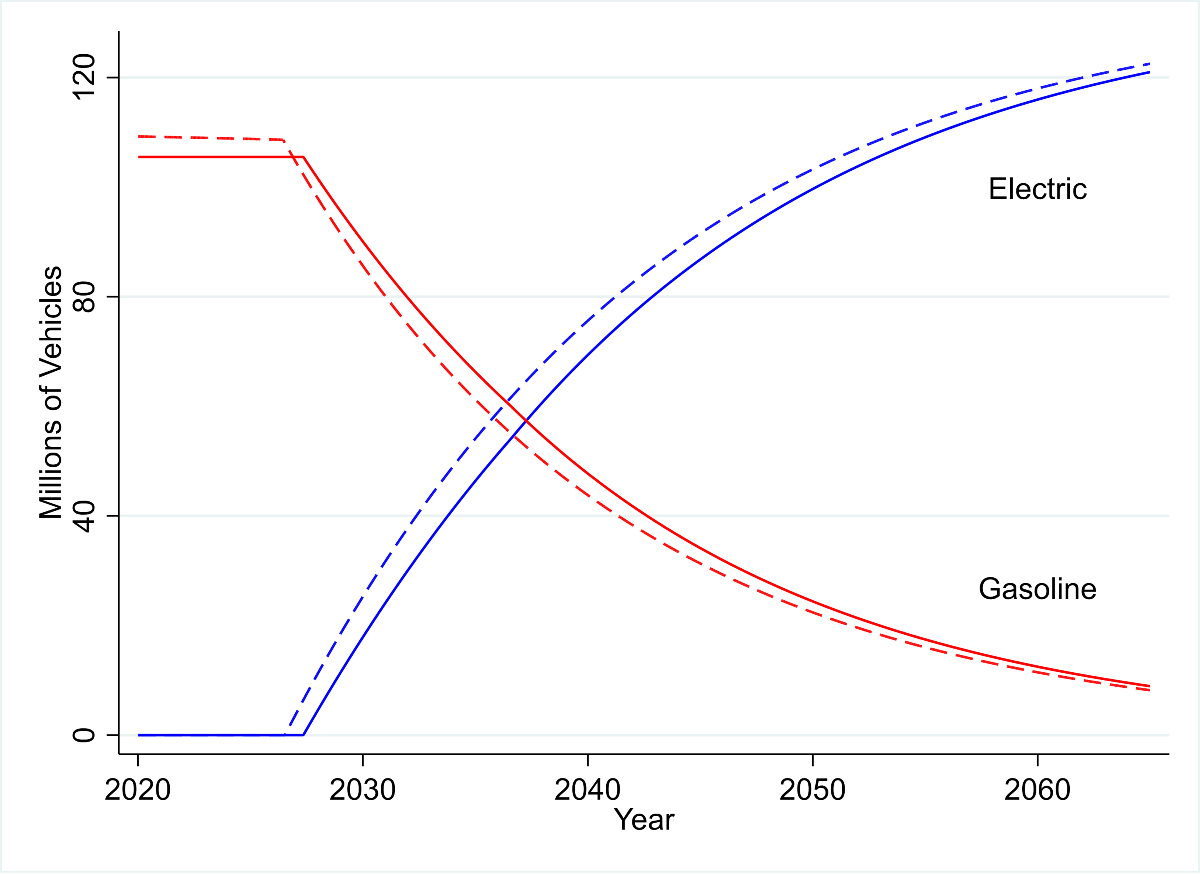As electric vehicles become commercially viable, they have the potential to yield dramatic reductions in air pollution. The UK plans to have no gasoline vehicles by 2030, Norway by 2025, and California by 2035. But what is the best policy to achieve that? Is banning an effective option? Stephen P. Holland, Erin T. Mansur, and Andrew J. Yates provide a framework for assessing costs and benefits, elucidating key unknown parameters, and designing effective policies to discourage the use of gasoline.
Transportation is a substantial source of global and local air pollution. Several new technologies hold promise for decreasing this pollution, including electric vehicles, fuel cell vehicles, biofuel-powered vehicles, and improved gasoline vehicles. Of this suite of technologies, electric vehicles are unique in that they are becoming commercially viable and have the potential to yield dramatic reductions in air pollution.
As a result, many jurisdictions are considering banning gasoline vehicles: for example, Norway by 2025, UK by 2030, and California by 2035. In our recent paper, “The electric vehicle transition and the economics of banning gasoline vehicles,” we analyse questions about whether it would ever be optimal to stop producing gasoline vehicles, about the timing of electric vehicle adoption, and how the timing is affected by policies such as an optimal gasoline vehicle production ban. Our model accounts for recent trends in falling costs of electric vehicles, reduced emissions from the electric grid, and—most crucially—the degree of substitutability between gasoline and electric cars. We calibrate the model for the U.S. new vehicle market.
If electric cars are never going to be a good substitute for gasoline cars, then a ban would be very costly to society. On the other hand, if they are great substitutes, then a ban would be mostly unnecessary as the market will soon adopt them as costs fall. The middle ground is where policy can make an important difference. Some customers, ignoring the effects of pollution from the vehicles, might still want gasoline cars but a ban would force them to adopt electric vehicles.
Our model sheds light on the performance of bans and other policies for this middle case, relative to the best possible policy for society (a differentiated tax on miles driven by gasoline and electric vehicles). We first show that having no policy would slow the timing of EV adoption relative to what would happen under the best policy (see Figure 1).
Figure 1. Best policy case (solid lines) versus no policy case (dotted lines)

Further, the best policy would phase out production of gasoline cars over time. This differs from a ban where we would expect consumers to stockpile gasoline cars just before the ban takes effect (see Figure 2). Nevertheless, a ban does offer an improvement relative to no policy.
Figure 2. Best policy case (solid) versus gasoline production ban (dotted)

We also consider a novel policy for the transition to electric vehicles.
What if we used a tradable quota system like what was used to phase out leaded gasoline during the 1980’s? Car manufacturers would be given a fixed number of credits to build gasoline cars and they could choose when to use them or sell them to other manufacturers if they no longer wanted to produce gasoline vehicles. Under this quota policy, the transition to EVs is much closer to the best policy than with a ban and there is no stockpiling (see Figure 3).
Figure 3. Best policy case (solid) versus gasoline production tradable quota (dotted)

Many jurisdictions currently offer a subsidy for the purchase of an electric vehicle. These subsidies can hasten the transition to electric vehicles. Our model shows that a correctly chosen subsidy generates about the same benefits to society as a ban and is generally inferior to the tradable quota policy.
An important caveat to these results is that assumption that the policy in question is set according to an accurate assessment of the substitutability between gasoline and electric cars. If, however, policy is set based on an incorrect perception of substitutability, then both the tradable quota and ban lead to very poor outcomes. For example, if electric vehicles are poor substitutes, but nevertheless a ban is put in place, then the resulting loss to society per year is about 200 per cent of the annual health costs from air pollution and damages from climate change due to passenger vehicles. In contrast, a purchase subsidy is much less sensitive to this type of error.
The transformative potential of electric vehicles suggests that electrification of transportation could contribute significantly to solving problems of air pollution and climate change. However, policies to successfully promote this transformation require a careful balancing of benefits and costs. Our modelling provides a framework for assessing these costs and benefits, elucidating the key unknown parameters, and designing effective policies.
♣♣♣
Notes:
- This blog post is based on The Electric Vehicle Transition and the Economics of Banning Gasoline Vehicles, American Economic Journal: Economic Policy (forthcoming)
- The post expresses the views of its author(s), and do not necessarily represent those of LSE Business Review or the London School of Economics.
- Featured image by Jacek Dylag on Unsplash
- When you leave a comment, you’re agreeing to our Comment Policy






I don’t think that an outright ban on gasoline cars is the answer here. If anything, I believe that they can coexist in the same market as electric vehicles, providing competitive options for buyers.